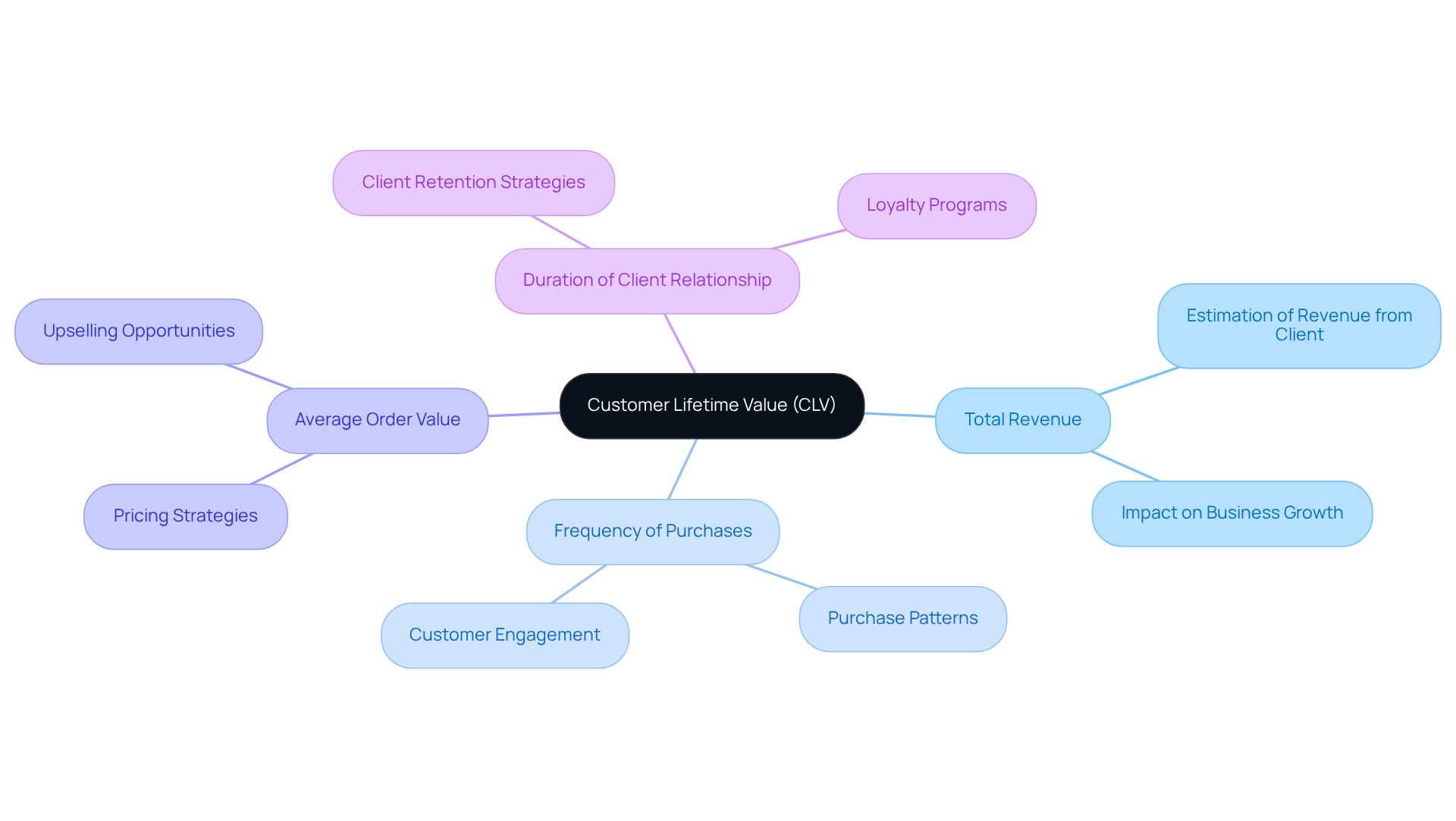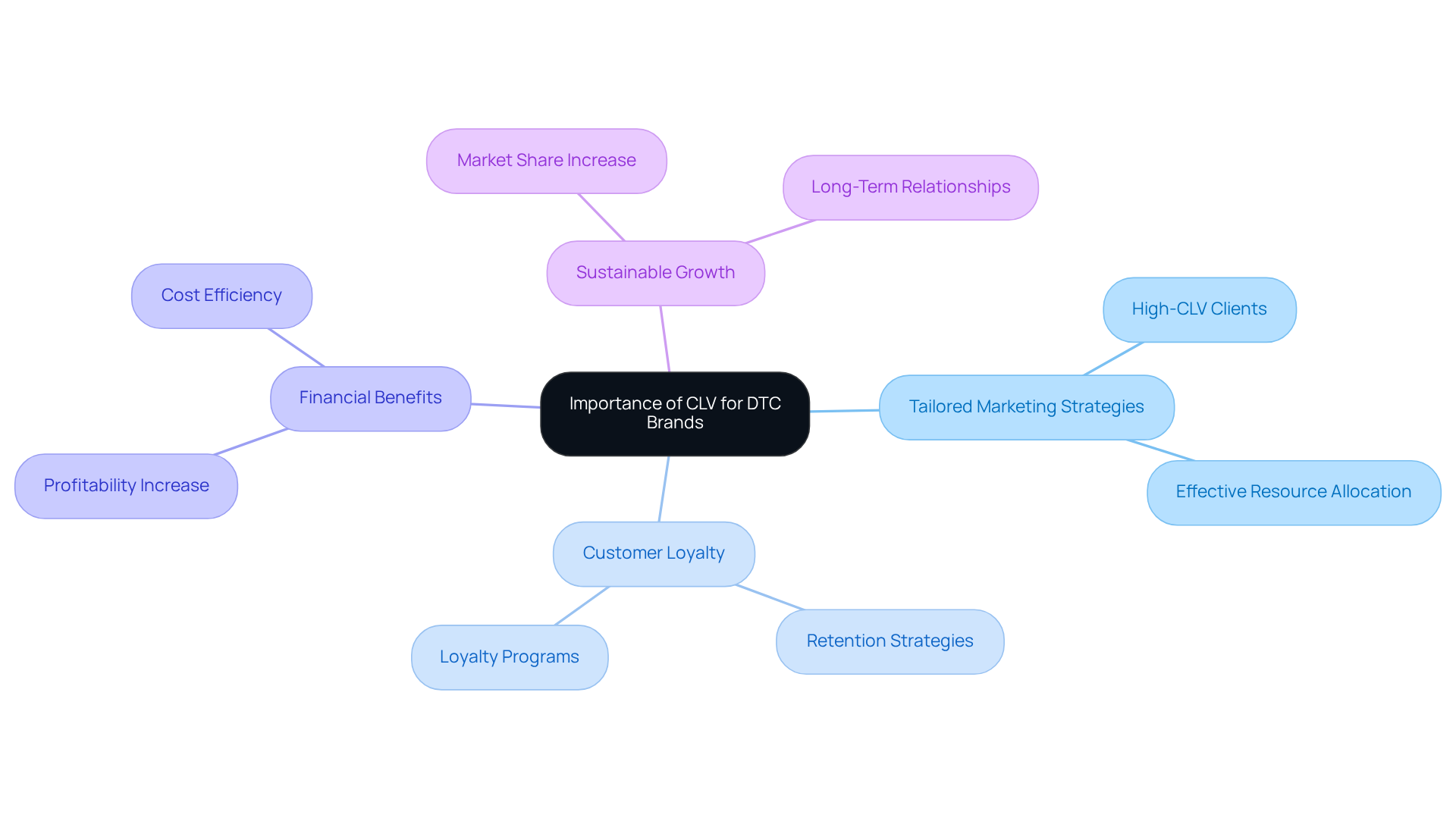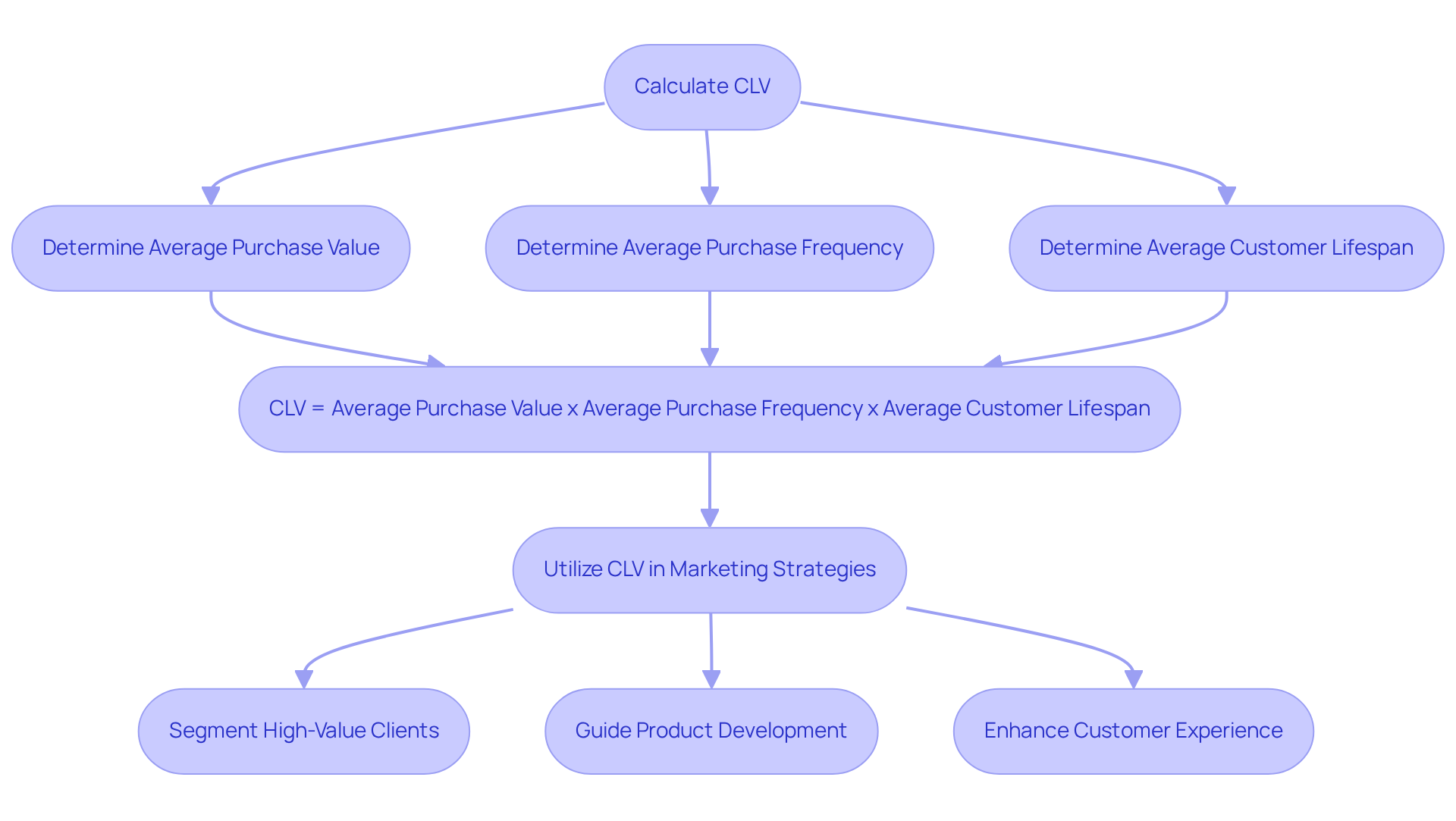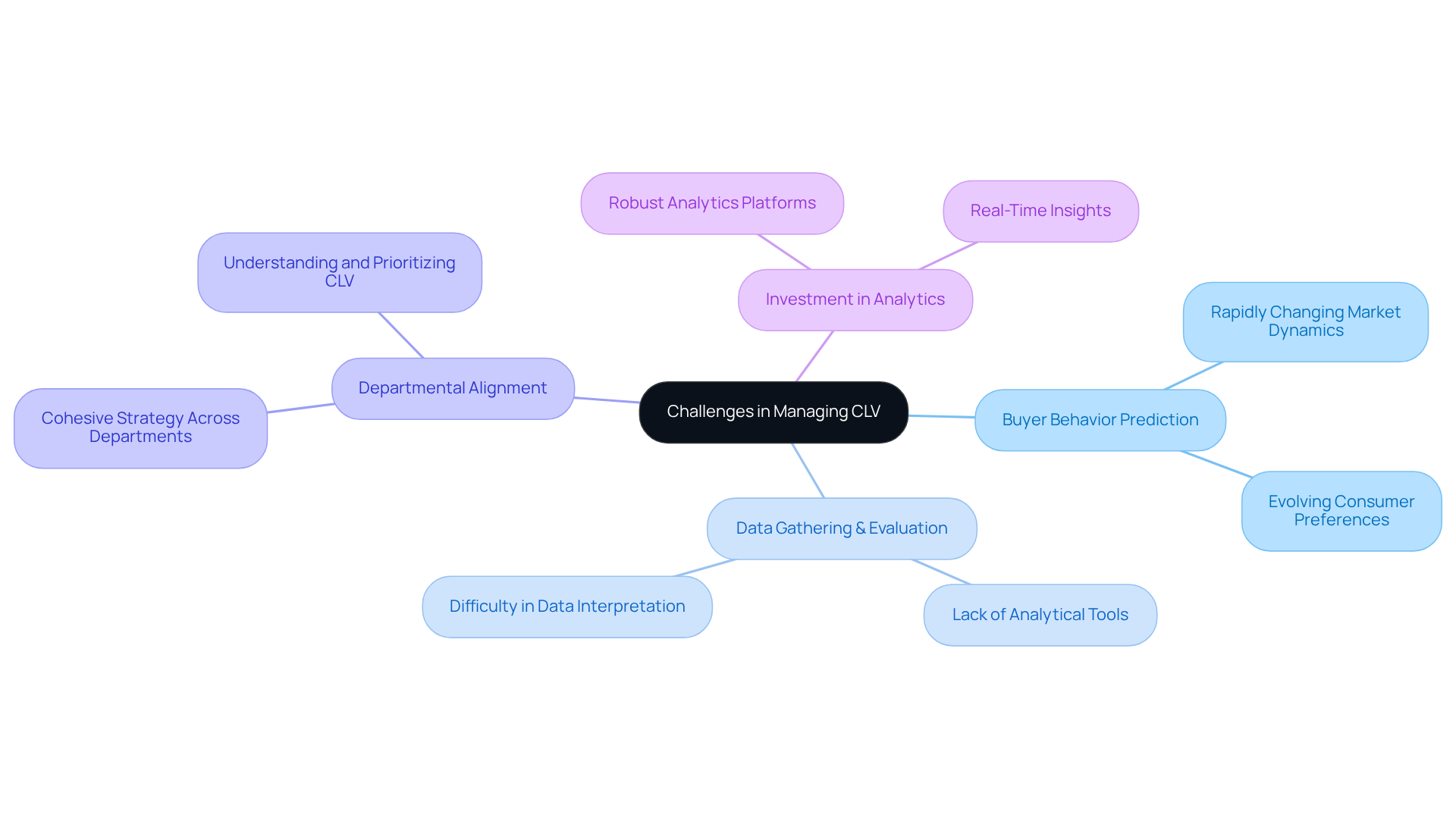
Overview
This article delves into the critical concept of Customer Lifetime Value (CLV) for direct-to-consumer (DTC) brands, asserting its vital role in shaping effective marketing strategies and bolstering customer retention.
Understanding CLV is not merely beneficial; it is essential for identifying high-value customers. By accurately calculating CLV, companies can tailor their marketing efforts to meet the specific needs of these customers, ultimately driving sustainable growth and profitability in an increasingly competitive market.
The insights provided herein emphasize the necessity for DTC brands to leverage CLV as a strategic tool, ensuring they remain ahead of the curve in their marketing endeavors.
Introduction
Understanding the intricacies of customer lifetime value (CLV) is essential for direct-to-consumer (DTC) brands aiming for sustainable growth in an increasingly competitive landscape. This vital metric illuminates the potential revenue from individual customers and informs strategic decisions concerning marketing investments and customer retention efforts. However, as market dynamics shift and consumer preferences evolve, DTC brands must grapple with the challenge of accurately predicting and leveraging CLV to maximize profitability.
Define Customer Lifetime Value (CLV)
Customer lifetime value (CLV) represents a crucial metric that estimates the total revenue a business can anticipate from a single client account throughout the entire duration of their relationship. This value encompasses all purchases made by the client, taking into account the frequency of purchases, average order value, and the anticipated duration of the client relationship.
Understanding (CLV) is essential for companies as it informs how much to invest in attracting new clients and retaining existing ones. Particularly for direct-to-consumer (DTC) companies, where relationships with clients are often direct and personal, accurately calculating customer lifetime value (CLV) provides invaluable insights into client behavior and profitability.

Explain the Importance of CLV for DTC Brands
For DTC companies, customer lifetime value (CLV) is a pivotal metric that fundamentally shapes various facets of business strategy. By identifying their most valuable clients, companies can tailor their marketing strategies to enhance engagement and retention. Understanding customer lifetime value (CLV) enables businesses to , prioritizing client acquisition tactics that yield the highest returns. Notably, DTC brands within the top 25 percent exhibit a customer lifetime value (CLV) five times greater, underscoring the necessity of focusing on high-CLV individuals.
Furthermore, the probability of selling to an existing client is up to 14 times greater than acquiring a new one, emphasizing the critical need to prioritize customer loyalty. Additionally, a mere 5% increase in customer loyalty can lead to a profitability surge of 25% or more, highlighting the financial benefits of loyalty strategies. Customer lifetime value (CLV) is also essential in evaluating the effectiveness of loyalty programs, as retaining these clients can significantly boost customer lifetime value (CLV) and profitability.
In an environment where client acquisition costs are on the rise, leveraging customer lifetime value (CLV) not only promotes sustainable growth but also enhances overall financial performance. Brands that prioritize customer loyalty and customer lifetime value (CLV) are three times more likely to increase their market share compared to those focusing solely on acquisition. Moreover, mapping the client journey for each persona is crucial for pinpointing pain points and improving service, thereby elevating retention rates.
In summary, customer lifetime value (CLV) stands as a cornerstone of effective marketing strategies.

Outline How to Calculate and Utilize CLV
Calculating customer lifetime value (CLV) is a crucial process that involves several steps. It typically starts with determining the average purchase value, the average purchase frequency, and the average lifespan of a client. This formula can be succinctly summarized as:
CLV = (Average Purchase Value) x (Average Purchase Frequency) x (Average Customer Lifespan).
For example, consider a client who spends an average of $100 per transaction, makes purchases four times annually, and maintains their relationship with the brand for five years. In this case, their CLV would amount to $2,000.
Effectively utilizing customer lifetime value (CLV) means incorporating it into your marketing strategies. Brands can segment clients based on their customer lifetime value (CLV), which enables targeted marketing campaigns that specifically cater to high-value individuals. Furthermore, understanding customer lifetime value (CLV) can guide product development and service improvements, ensuring that the overall experience aligns with the expectations of high-CLV segments. By prioritizing customer lifetime value (CLV) in your strategic planning, you not only enhance customer satisfaction but also drive sustainable growth for your business.

Challenges in Managing CLV
Effectively managing customer lifetime value (CLV) poses significant challenges for DTC companies. A primary concern lies in the precise prediction of buyer behavior, which is often influenced by rapidly changing market dynamics and evolving consumer preferences. Many companies encounter difficulties in data gathering and evaluation, particularly if they lack sophisticated analytical tools or the expertise to interpret the data efficiently.
Furthermore, it is essential that all departments—marketing, sales, and support—understand and prioritize CLV, as achieving this requires a cohesive strategy throughout the organization. To address these challenges, DTC companies must invest in that provide real-time insights and foster a culture that values client data.
This strategic focus on customer lifetime value (CLV) can lead to substantial improvements in client retention; studies indicate that increasing retention rates by just 5% can boost profits by 25% to 95%. By prioritizing customer insights and aligning their strategies accordingly, brands can enhance their customer lifetime value (CLV) management and drive sustainable growth.

Conclusion
Understanding customer lifetime value (CLV) is essential for direct-to-consumer (DTC) brands seeking to optimize their marketing strategies and enhance profitability. This metric quantifies the total revenue expected from a single customer throughout their relationship with the business and informs critical decisions regarding customer acquisition and retention. By prioritizing CLV, DTC companies can fortify their relationships with high-value customers and tailor their marketing efforts to maximize returns.
Key insights from the article reveal that prioritizing customer loyalty can significantly impact a brand's financial performance. Existing customers are far more likely to make repeat purchases than new ones; thus, investing in retention strategies can yield substantial profitability gains. While the calculation of CLV is straightforward, it requires a nuanced understanding of customer behavior. Integrating this metric into strategic planning enhances marketing effectiveness and customer satisfaction.
Ultimately, leveraging customer lifetime value is not merely a tactical approach; it represents a strategic imperative for DTC brands seeking sustainable growth in a competitive landscape. By embracing robust analytics and fostering a customer-centric culture, businesses can navigate the challenges associated with CLV management and unlock new opportunities for success. Effectively understanding and utilizing CLV can set brands apart, driving not just market share but also long-term loyalty and profitability.
Frequently Asked Questions
What is Customer Lifetime Value (CLV)?
Customer lifetime value (CLV) is a metric that estimates the total revenue a business can expect from a single client account over the entire duration of their relationship.
What factors are considered when calculating CLV?
CLV takes into account all purchases made by the client, including the frequency of purchases, average order value, and the anticipated duration of the client relationship.
Why is understanding CLV important for companies?
Understanding CLV is essential for companies as it helps them determine how much to invest in attracting new clients and retaining existing ones.
How does CLV specifically benefit direct-to-consumer (DTC) companies?
For DTC companies, where relationships with clients are often direct and personal, accurately calculating CLV provides valuable insights into client behavior and profitability.
FAQs











